“I felt less pressure to be perfect”: using vTimeXR for L2 speaking practice
 By Tricia Thrasher, PhD, Research Manager at Immerse.
By Tricia Thrasher, PhD, Research Manager at Immerse.
DOI: https://www.doi.org/10.69732/JCAE4165
As language teachers, we’ve all worked at some point with students who experience foreign language anxiety – or FLA for short. For some students, this anxiety only really comes to the surface during high-stakes oral exams. For others, it pervades every aspect of their language learning experience and ultimately hinders them from making progress and becoming proficient speakers.
Students experience FLA for a variety of reasons. Some are more prone to anxiety to begin with. Others are afraid of being negatively perceived by their peers or teachers. For some, they feel like they must be perfect and are simply terrified of making mistakes. Despite where it comes from though, the fear that some students experience when given the opportunity to practice speaking the language they are learning can be paralyzing, with students often reporting things like “my mind just went blank” or “I know the words, but for some reason, they don’t come out.”
However, as language educators, we know that speaking the language is key to one day becoming fluent in it. Memorizing vocabulary and grammatical concepts only gets students so far. They need ample opportunity to put this knowledge to use so that it becomes automatic, and so that they can one day converse with ease. They also need to be comfortable making mistakes, as these mistakes in themselves often become learning opportunities that help them improve.
Given this, and the fact that research has found that FLA greatly impacts how successful a learner will be in acquiring a language (Botes et al.., 2020; Teimouri et al., 2019; Zhang 2019), I wanted to explore ways that I could help lower my students’ FLA, especially during speaking tasks which are largely considered to be the most anxiety-inducing. This led me to virtual reality (VR). In this article, I will share my experience with using VR as a language learning tool, putting it in the context of my research study examining how VR can reduce FLA and, in turn, improve oral performance for language learners of French.
Virtual Reality and Language Learning
VR can be defined as a fully immersive 360° experience that is often created using a headset. Different headsets offer varying degrees of immersion, with more expensive devices typically rendering a more authentic, realistic experience. At the time of writing this article, one of the most popular VR headsets on the market is the Meta Quest 2.
I remember being truly amazed the first time I was able to put on a VR headset and check out an app that had been specifically created for language learning: ImmerseMe. I immediately started thinking about how this technology could be used to give students more realistic speaking practice and was excited about the potential. I also started wondering if students would be more comfortable doing speaking activities in VR than in person. It did feel more fun and game-like, after all.I ended up digging into the research being conducted on how desktop virtual worlds, a less-immersive type of VR, can benefit language learning and the results were largely positive. Indeed, study after study found that students felt more comfortable and were less anxious when completing activities in virtual worlds like Second Life (Melchor-Coutu 2016 & 2018; Mroz, 2015; Reinders & Wattana, 2014; Wehner et al., 2011). This was due to several reasons: the fun, game-like qualities, that students were represented by avatars and felt hidden, and that students didn’t have to really make eye contact with others while on these platforms.
These findings were extremely encouraging. However, the research at that point had been largely conducted on desktop virtual worlds and based on students’ qualitative feedback or on 1-to-5 point Likert-scale questionnaires where students ranked how anxious they felt. I wanted to dig a little bit deeper and see if fully immersive VR could lower both self-reported and physiological (e.g., salivary cortisol and heart rate) anxiety. I also wanted to see whether the lower anxiety that VR affords makes a difference in students’ language performance, specifically during spontaneous interpersonal speaking tasks.
I ended up designing and conducting a research study using the social VR platform vTimeXR to figure out the answers to these questions. I compared students’ performance and anxiety during tasks they completed in vTimeXR to comparable tasks they completed in their normal classroom and on Zoom. Although I will talk about the study below to provide necessary context, this article will largely focus on giving an overview of the vTimeXR platform and the types of activities that I had students do with the aim of giving readers ideas of how they could use this platform with their own students. I will also discuss lessons learned and the challenges that I encountered when using VR with my students to hopefully help you avoid some of the same pitfalls.
What is vTimeXR?
Let’s first dig into the VR platform that I used.
vTimeXR is a social VR platform, meaning it was primarily created to allow users to meet up in real-time and interact with each other. That being said, it is different from some other VR applications where users interact with AI computer bots. Although vTimeXR was not designed specifically for language teaching and learning, it was ideal for my study, because I wanted a space where students could talk and interact with each other.
The platform offers over 25 different locations in which students can immerse themselves with up to 3 other students (i.e., 4 total at a time). These locations range from more traditional settings (e.g., a meeting room, a Japanese garden) to more unconventional contexts (e.g., the edge of a cliff, an abandoned underwater ship). There is also the possibility to create your own locations by bringing in 360° images. For example, you could bring in a 360° image taken inside Notre Dame de Paris to immerse your students in the space.
To increase presence or the feeling of really ‘being there,’ all vTimeXR’s fully immersive 360° settings include visual and audio effects. For example, users interacting at Terrasse de l’amour (a rooftop bar in Paris) can hear background noises such as the sound of cars driving by on the street below or other patrons dining and clinking glasses. They can also see smoke coming out of the chimney tops of surrounding buildings and birds flying by. Depending on users’ personal preferences, they can also adjust the volume of the sound effects to make them softer or louder. You can see images of several of vTime’s settings below. All images are the property of vTimeXR limited.
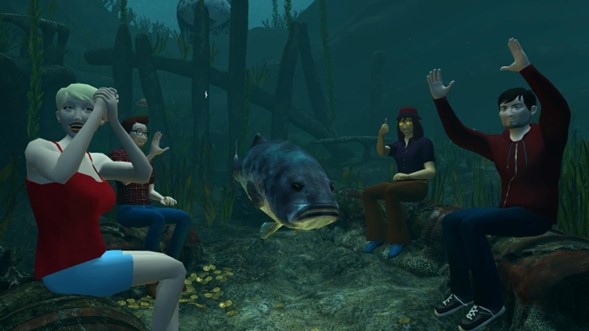
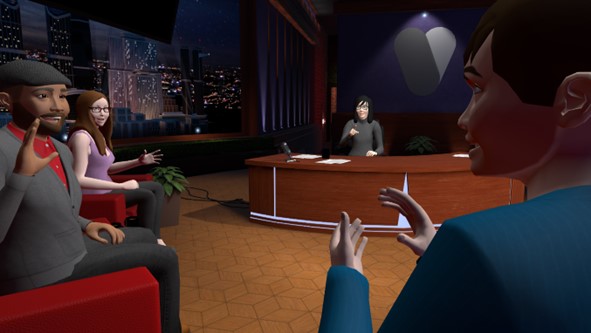
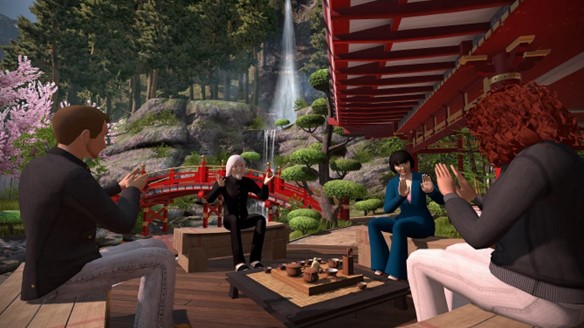
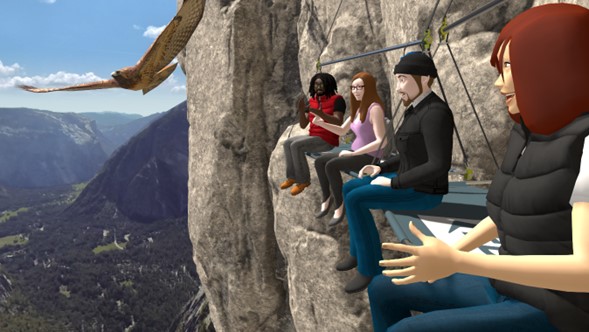
How vTimeXR Was Used
This study using vTimeXR was conducted with 38 intermediate learners of French as a foreign language over three semesters from Fall 2020 through Fall 2021. All students were enrolled in an Oral French course at their university during their respective semesters, a course which was designed to help them reach Advanced-Low ACTFL oral proficiency and thus placed a large focus on developing students’ listening and speaking skills.
Since this study took place during the height of the COVID-19 pandemic, all students were loaned a personal Oculus Go VR headset (Figure 5) to use from home throughout the semester. These headsets were purchased either through grant funding received from Duolingo or loaned from the university where I was conducting my PhD research at the time.
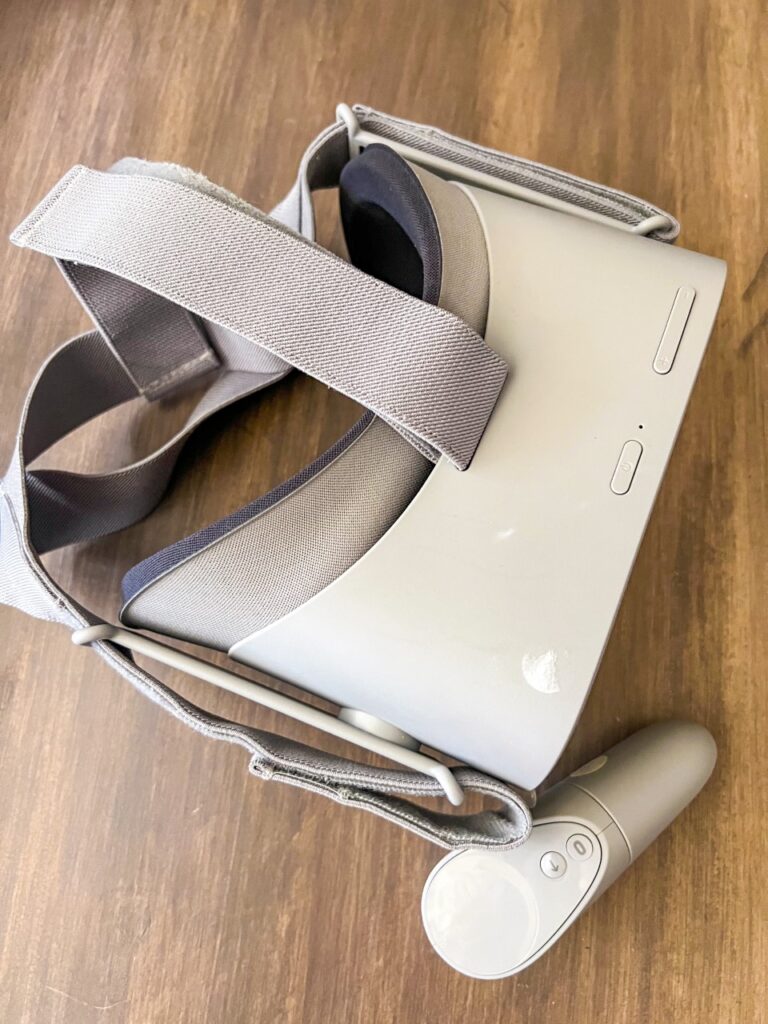
At the beginning of each semester, students completed several questionnaires to learn more about their background and how prone they were to experiencing FLA. Then, two class periods were spent on training students to use their Oculus Go headsets and the vTimeXR platform. This training was conducted in English and included teaching students how to download and access the app, go through the app’s tutorial, create and customize their personalized avatar, navigate to different destinations, and add or join their classmates.
After the training, students worked in groups of three to complete interpersonal consensus-building tasks in French with their peers throughout the semester. More information on the consensus-building activities and how they were created is given below. Some tasks were completed in vTimeXR, while others were done in their normal classroom or on Zoom. This allowed me to compare how the three different environments impacted students’ anxiety and performance in French.
All of the participants’ conversations during the tasks were both audio and video recorded for further analysis. Their heart rate was also continuously collected during the tasks using Polar OH1 heart rate monitors, and they self-reported their anxiety immediately after each activity to assess whether VR lowered their FLA or not. Finally, at the end of the entire study, students partook in 15-to-20-minute semi-structured follow-up interviews to give their opinions of how VR impacted their learning experience. These interviews were audio-recorded, transcribed, and finally coded and analyzed using thematic analysis.
Consensus-Building Activities
Consensus-building tasks are essentially designed so that students have to work throughout the activity to come to an agreement, or consensus, by the end. Seven activities were created for these students that all related back to themes that were being discussed in their course at the time they were completed. These themes included: (1) YouTube content creators, (2) technology, (3) sustainability/environmental issues, (4) education, (5) social media, (6) sports, and (7) art. You can see an overview of the tasks and the respective vTimeXR environment that was used for each in Table 1.
| Theme | Main Objective | Role 1 | Role 2 | Role 3 | vTimeXRDestination | |
|---|---|---|---|---|---|---|
| 1 | YouTube Content Creators | Come up with an idea for a new YouTube series for the social media company, Roxane, that you work for in Paris. | Come up with an idea for a new YouTube series for the social media company, Roxane, that you work for in Paris. | Come up with an idea for a new YouTube series for the social media company, Roxane, that you work for in Paris. | Come up with an idea for a new YouTube series for the social media company, Roxane, that you work for in Paris. | Come up with an idea for a new YouTube series for the social media company, Roxane, that you work for in Paris. |
| 2 | Science & Technology | Come up with an idea for a new technology that could solve a problem in society. | Come up with an idea for a new YouTube series for the social media company, Roxane, that you work for in Paris. | Come up with an idea for a new YouTube series for the social media company, Roxane, that you work for in Paris. | Come up with an idea for a new YouTube series for the social media company, Roxane, that you work for in Paris. | Come up with an idea for a new YouTube series for the social media company, Roxane, that you work for in Paris. |
| 3 | Environment | Organize a workshop that will teach locals how to protect the environment. | Come up with an idea for a new YouTube series for the social media company, Roxane, that you work for in Paris. | Come up with an idea for a new YouTube series for the social media company, Roxane, that you work for in Paris. | Come up with an idea for a new YouTube series for the social media company, Roxane, that you work for in Paris. | Come up with an idea for a new YouTube series for the social media company, Roxane, that you work for in Paris. |
| 4 | Education | Decide how budget cuts in the school will be handled. | Come up with an idea for a new YouTube series for the social media company, Roxane, that you work for in Paris. | Come up with an idea for a new YouTube series for the social media company, Roxane, that you work for in Paris. | Come up with an idea for a new YouTube series for the social media company, Roxane, that you work for in Paris. | Come up with an idea for a new YouTube series for the social media company, Roxane, that you work for in Paris. |
| 5 | Social media | Come up with an idea for a new type of social network. | Come up with an idea for a new YouTube series for the social media company, Roxane, that you work for in Paris. | Come up with an idea for a new YouTube series for the social media company, Roxane, that you work for in Paris. | Come up with an idea for a new YouTube series for the social media company, Roxane, that you work for in Paris. | Come up with an idea for a new YouTube series for the social media company, Roxane, that you work for in Paris. |
| 6 | Sports | Work as part of the planning committee for the 2024 Paris Olympic games. | Come up with an idea for a new YouTube series for the social media company, Roxane, that you work for in Paris. | Come up with an idea for a new YouTube series for the social media company, Roxane, that you work for in Paris. | Come up with an idea for a new YouTube series for the social media company, Roxane, that you work for in Paris. | Come up with an idea for a new YouTube series for the social media company, Roxane, that you work for in Paris. |
| 7 | Art/Culture | Work as part of the planning committee for the 2021 Festival de Cannes. | Come up with an idea for a new YouTube series for the social media company, Roxane, that you work for in Paris. | Come up with an idea for a new YouTube series for the social media company, Roxane, that you work for in Paris. | Come up with an idea for a new YouTube series for the social media company, Roxane, that you work for in Paris. | Come up with an idea for a new YouTube series for the social media company, Roxane, that you work for in Paris. |
Table 1 – Overview of consensus-building activity themes and vTimeXR destinations
For each activity, students first received task instructions regarding what they needed to reach a consensus on. Each student was assigned to play specific opposing roles in the conversation in order to give them inspiration and ideas for their discussion. For example, for the education activity, students had to reach an agreement regarding hypothetical budget cuts that their school system was facing in response to a financial crisis. Students were assigned to play either the school principal (Role 1), a teacher (Role 2), or a student representative (Role 3). They all received details regarding how their character thought it would be best to handle the budget cuts (see Figure 6). They then had to use this information to make an argument as to why the budget cuts should be handled in that specific way. For all tasks, they had 20 to 30 minutes to convince each other of their views and to come to an agreement that suited them all before sharing their ideas with the larger class.
Thème 4 : EducationIntroduction Utiliser votre rôle pour guider votre discussion : Rôle 1 : Le directeur de l’école Vous avez quelques idées sur la manière de réduire vos dépenses.
Cependant, vous ne savez pas quoi faire. Vous voudriez discuter avec l’un des professeurs de l’école et le représentant d’étudiant pour avoir leurs opinions. Rôle 2 : L’un des enseignants du lycée Pour vous, augmenter le nombre d’étudiants dans chaque classe n’est pas du tout possible. Il y a déjà trop d’étudiants par classe et il est trop difficile d’enseigner. En plus, faire cela réduit la qualité de l’enseignement pour les étudiants parce qu’il est plus difficile de leur donner des réactions individuelles. En plus, vous préférez ne pas réduire le nombre de bourses que le lycée offre aux étudiants parce que cela permet aux étudiants qui n’ont pas beaucoup d’argent de venir au lycée. Pour vous, la meilleure option, c’est d’éliminer la technologie qui est dans les salles de classes. Sans formation, la technologie qui coûte souvent chère est très difficile à utiliser pour les enseignants et elle peut être distrayante pour les étudiants. Rôle 3 : Le représentant d’étudiant Pour vous, éliminer la technologie qui est dans les salles de classe n’est pas une bonne idée. Les étudiants sont jeunes et ils sont habitués à utiliser la technologie. En plus, des études montrent que les étudiants, surtout ceux qui font partie de la Génération Z, apprennent mieux en utilisant la technologie parce qu’ils sont plus intéressés. En plus, vous préférez ne pas réduire les activités extrascolaires parce que vous pensez qu’elles sont bonnes pour la santé mentale des étudiants. Pour vous, la meilleure option, c’est augmenter le nombre d’étudiants dans chaque classe. Si les enseignants utilisent plus de technologie, ils pourront enseigner à plus d’étudiants en même temps. |
|---|
Table 2 – Education themed consensus-building task
To ensure that vTimeXR enhanced learners’ work during the consensus-building tasks they did in VR, vTimeXR destinations were chosen that aligned with the theme of the task students were doing. This provided students with a realistic context for completing their activity. For example, when completing the task about sustainability and the environment, students were immersed in “The Retreat,” a Japanese garden. In this setting, students were surrounded by cherry blossom trees, a stream, rocks, and a waterfall. They could also hear water flowing down the stream in their sound effects. Matching each task with an appropriate vTimeXR destination was important, and many students mentioned in their interviews that the environments actually added to their tasks by giving them ideas of what to talk about with their peers and how to further their conversation.
You can access all the original consensus-building activities that were created for this study here.
Key Findings
Several key findings emerged from this study. To remain within the scope of this article, I will highlight some notable ones here and why they are important.
A main finding was that VR helped reduce FLA. Specifically:
- Students, especially those who had high FLA to begin with, had lower self-reported anxiety when completing tasks in VR compared to tasks they completed in their normal classroom or on Zoom.
- Students’ heart rate was also lower during VR tasks compared to tasks on Zoom and in the classroom.
This is important because collecting a physiological measurement of anxiety further validates previous research that has found that students report lower anxiety in VR. Given the debilitating impact of anxiety on language learning, it is crucial for language teachers to set their students up for success by immersing them in an environment that can optimize their learning experience. These findings suggest that VR could be an ideal environment for doing so.
During their debriefing interviews, many students reported that they were more comfortable in VR because they were physically shielded from others behind their avatar, because it felt fun and like a game, and because they didn’t have to make eye contact or worry about other types of body language in VR.
For example, one participant, Hannah (pseudonym) explained that:
It felt less like an intense nerve-wracking environment, I think. Cause it did feel more like a game, you know, something maybe closely related to video games. […] If anything I think it made it feel more casual, more relaxed. Maybe less like a formal classroom setting (April 23, 2021).
Another participant, Jessica (pseudonym) commented on how VR reduced certain visual cues that can contribute to anxiety, saying:
In person it’s easier to interpret body language and I think it’s a little scary. I guess because you have to worry more about your whole body instead of just your top half [like on Zoom] or just your voice [like in VR]. In person it’s more forced eye contact. You sort of have to look at them. [On] Zoom, you have other space to look at and I feel like it’s normal generally to not stare at the camera. Or like you can stare at them but you’re not actually staring at them. That’s the same for VR. Like [in] VR you don’t have to care about what you look like generally, cause you’re just a character. […] So, like whenever we did the VR things, I generally felt more relaxed I guess and just like – I don’t know, I feel like [it was] easier to just talk and not worry too much about any other part of anything else (November 17, 2020).
Another main finding was that the lower anxiety afforded by VR helped students speak French better. Specifically, when students’ speech was rated and coded by 4 native-speaking raters, it was found that:
- Students were more comprehensible and intelligible when they were in VR, and they were less anxious.
- Students produced more fluent speech in VR compared to the other two settings.
- Students produced more complex language during their consensus-building tasks in VR compared to on Zoom and in the classroom.
This is important because comprehensibility, intelligibility, and fluency are all vital for being able to communicate successfully in the target language.
While lower anxiety seems to be a main reason students performed better in VR, their interviews brought to light some other factors that helped them be more successful. Many students also mentioned that they felt they could express themselves more easily in VR because being fully immersed inside the headset removed outside distractions. This allowed them to solely focus on the task at hand and communicating with their peers.
For example, one participant, Martin (pseudonym) said:
Whenever we were doing the VR, it just cut out a lot of the distractions that weren’t part of the VR atmosphere, so, I think that that really helped cause like doing it on Zoom, I’m just like seeing a bunch of other things on my screen right now and then in person it’s easy to look away or do something on your phone. So, when you’re doing the VR thing, that really helped because I couldn’t do anything else. So, it really helped just cut all that way so that I couldn’t really think about that right now, and I could just focus on the French (November 30, 2021).
Lastly, students also mentioned that they felt their interactions were more natural in VR than on Zoom. In fact, they felt that VR interactions resembled in-person interactions more, even though they were not really seeing each other’s faces. This was largely due to the heightened degree of presence and co-presence (the feeling of really being in VR with others) that students experienced while in vTimeXR. Taken together with the findings above, this suggests VR could offer a better solution to distance learning than Zoom since it can immerse students together in contextualized, less-distracting environments that contribute to their learning.
Lessons Learned
I learned a lot about implementing VR into a language classroom and curriculum while conducting this study. Between the study described here and the pilot study that I did before this one, I used these headsets with students over 6 semesters or 3 academic years. This study also took place during COVID-19, which brought new challenges since I had to ensure participant safety.
1. Training
I really cannot emphasize enough the importance of training. This goes for training both yourself and your students to use the headsets and application you decide on. VR is not intuitive for everyone, and I recommend you practice teaching someone else how to use a headset before trying to explain it to an entire classroom of students. This will give you an idea of the types of questions that will come up when someone tries out a headset for the first time and help you be better prepared. Once you are ready to teach your students to use their headsets, I suggest planning to spend two class periods on that alone. If possible, I would also do the training in their native language in person and have an assistant who can go around and help you answer individual students’ questions as they arise. I conducted a few training sessions over Zoom by myself during COVID-19, and it was very difficult since you cannot physically help students put on their headset or navigate the controls. I also highly recommend that you take advantage of the casting feature available on most headsets so that you can a) demo to students what they should see once in the headset and b) see what they are doing once they are wearing their headset and better walk them through various technological hiccups that can arise.
2. Equipment and classroom setup
Setting up VR equipment before class can take a lot of time, but it will save you time during class and help things run more smoothly. I recommend triple checking that all your headsets are fully charged and connected to WiFi (sometimes school networks are more difficult to connect to due to their security features), and that the app you are using is both downloaded and recently updated on your headsets. This way, ideally, students will be able to come into class, put on their headset, and immediately get started working. If you have students using headsets from home, I suggest emailing them all before class to remind them to make sure the aforementioned tasks are done. If students are using headsets in the same classroom, you’ll want to make sure there is enough distance between them so that they don’t accidentally hit each other when gesturing with their controllers and so they do not hear each other in both VR and in person.
3. Obtaining and distributing headsets
Right now, the biggest problem with VR for a lot of educators is that headsets are expensive. The Meta Quest 2 headset, which is considered affordable by many, is $400 alone. Multiply that by the number of students in your class and things get very expensive quickly. Here are some suggestions to try to make this cheaper:
a. Consider buying a set of 3-4 headsets for your classroom and having students share them and rotate through VR and non-VR activities.
b. Companies like Meta are actively trying to distribute VR headsets to underserved K-12 schools. Reach out to their education department to ask about applying to receive a set of headsets for your school.
c. See if your school could purchase a set of headsets that could be used across subjects and teachers. This can help make the investment more worthwhile.
d. Many universities allow students to freely check headsets out of technology centers. Talk to these resources on campus to see if your students could do something similar.
e. On a similar note, more and more universities are building VR labs that have headsets in them. Reach out to yours to see if you can reserve a time for students to come in. Many STEM departments also have VR headsets. I was able to get access to several headsets for my research by talking to these departments and asking to borrow them.
f. If none of these options work, you can still experiment with VR using lower-quality devices like Google Cardboard that can work with students’ smartphones. These are about $5 a piece. vTimeXR is also available on mobile devices.
4. Privacy
When choosing a VR app, you will want to pay attention to privacy features to make sure that your students have a safe experience. I chose vTimeXR because it was a social VR platform where my students could meet up with each other. It was also one of the most private social VR options at the time that I started this study. However, given the social nature of it, students were still able to encounter strangers if they accidentally accepted them into their conversation. This did not happen often, but occasionally a student would hit the wrong button and end up talking to someone they did not know.
Conclusions
I think that VR is a fantastic tool. It allows you to immerse your students in contextualized, highly realistic environments where they can practice their language skills like they would in the real world. For many students, it is also seen as a safe space where they can make mistakes and continue to improve.
My research found that VR was effective in reducing foreign language anxiety and, in turn, helping students speak better French. This was encouraging, but it is not the only thing that VR is good for. Research has also found that VR can help with vocabulary acquisition, pragmatics, reading, and more.
If you are interested in trying VR with your students, I really encourage you to give it a go. I hope that this last part of this article will help you navigate some of the challenges that can come with using this technology.
References
Botes, E., Dewaele, J. M., & Greiff, S. (2020). The foreign language classroom anxiety scale and
academic achievement: An overview of the prevailing literature and a meta-analysis. International Association for the Psychology of Language Learning (IAPLL), 2(1), 26-56.
Retrieved from https://www.jpll.org/index.php/journal/article/view/botesetal
Melchor-Couto, S. (2016). Foreign language anxiety levels in Second Life oral interaction.
ReCALL, 29(1), 99-119. https://doi.org/10.1017/S0958344016000185.
Melchor-Couto, S. (2018). Virtual world anonymity and foreign language oral interaction.
ReCALL, 30(2), 232-249. https://doi.org/10.1017/S0958344017000398.
Mroz, A. (2015). The development of second language critical thinking in a virtual language
learning environment: A process-oriented mixed-method study. CALICO Journal, 32(3),
528-553. https://doi.org/10.1558/cj.v32i3.26386.
Reinders, H., & Wattana, S. (2014). Affect and willingness to communicate in digital game-
based learning. ReCALL, 27(1), 38-57. https://doi.org/10.1017/S0958344014000226.
Teimouri, Y., Goetze, J., & Plonsky, L. (2019). Second language anxiety and achievement: A
meta-analysis. Studies in Second Language Acquisition, 0(1), 1-25. https://doi.org/10.1017/S0272263118000311.
Wehner, A. K., Gump, A. W., & Downey, S. (2011). The effects of Second Life on the
motivation of undergraduate students learning a foreign language. Computer Assisted
Language Learning, 24(3), 277-289. https://doi.org/10.1080/09588221.2010.551757.
Zhang, X. (2019). Foreign language anxiety and foreign language performance: A meta-analysis.
The Modern Language Journal, 103(4), 763-781, https://doi.org/10.1111/modl.12590.
*Figures 1 – 4 are the property of vTimeXR Limited

